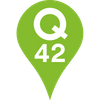Takeaways from the O’Reilly Solid conference
Last week the annual O’Reilly Solid conference was held at Fort Mason in San Francisco. Two days packed with “software, hardware, everywhere”.
Main takeaway / TL;DR
15 years ago the entry level to creating software was lowered far enough for people to easily step in. The number of software solutions (websites, webapps, mobile apps) exploded.
That same thing is now happening in the hardware industry. It’s becoming increasingly easier to prototype and manufacture physical things, and to get funding via crowdfunding or VCs. Fab labs around the world already give you access to a suite of industry-grade tools like 3d printers and lasercutters.
Fix real problems
Astro Teller, who works at Google[x], stated that software problems are relatively easily to solve, so a lot of people are working on them. To solve the real problems of this world, you should incorporate physical products into your solution. And that’s a lot harder. But as Tim O’Reilly mentioned: we should work on what is hard.
A related notion is to “design for how the world should work, not optimize how the world does work”. A good example is the windmill that went from the antique Dutch design, to the huge modern white versions, but have been reinvented as a flying version.
Software guy
The worlds of hardware and software are merging. By using software, the hardware is suddenly updatable so you can add functionality to your product after it’s shipped. And by using hardware, the software can reach new audiences and solve new problems.
I’ve seen this at work at the Philips Hue project that I worked on. The hardware is still the same, but by upgrading the software running on it, suddenly it’s possible to add new devices like the Tap or the Lightstrip to an existing setup.
Another good example mentioned by @abegong is Tesla’s reaction to two occurrances of an object that broke through the bottom of the car. By tweaking the software, they were able to globally raise the suspension of all Tesla cars while they’re driving at high speeds, in order to further minimize the likelihood of such an event. All products learned from that one mistake.
Creating a product
Designing new hardware happens in two phases: prototyping and mass-manufacturing. The first one can be quite easily done using hardware technologies like arduino / tessel / littlebits / spark.io, and software like noam (local pub-sub messaging) orelectric imp (hardware module that connects to the imp cloud).
Mass manufacturing is a lot harder. There’s no China button, it seems. But companies like Highway1 have the expertise to help you out on that front.
Where do we fit in?
It’s inspiring to see the possibilities and the relative ease with which the hardware prototyping phase can be done. Suddenly I’m thinking we should create a hardware device to dogfood our Internet of Things platform. The thought had crossed my mind earlier when I watched this amazing talk by BergCloud on their Little Printer.
After this conference, that idea is suddenly a lot more plausible. I’ll definitely be visiting Fab Lab Den Haag soon, and be looking for hardware meetups on meetup.com.
Internet of Things
Simone Rebaudengo from Frog Design noted that connectivity is used as a very long finger (aka remote api for hue). But in the future, this will change. Things will be connected to other things, not just to people. He made a prototype with toasters that suffered from peer pressure: when two toasters were in use, the third would try to get attention by moving its lever up and down. I really felt affection towards the neglected toaster! See the inspiring slides.
Mind-blowing
There’s a guy printing DNA! He printed a container with a hinge that could contain chemicals. When that micro-container comes in contact with a specific other cell, it opens up and delivers the chemicals. Imagine the possibilities… Suddenly the Star Trek Replicator doesn’t seem far off, nor does printing your dinner…
And then some
Ivan Poupyrev talked about “Interactive everything” at Disney World, where children can touch plants to play music or otherwise interact with the park itself. I saw a mini airflow generator that could do force feedback for your XBox Kinect. And a whole, whole lot more :) We’ll definitely be there next year!
